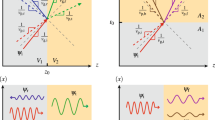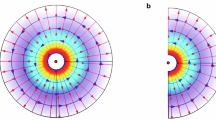Abstract
For the description of an electron by a wave equation, the simplest equation available is the Dirac equation, which in the usual notation reads  This corresponds to a point particle of charge e, spin ½ħ and magnetic moment eħ/2mc. This equation has met with marked success in describing an electron in static fields and slowly varying fields. For high-frequency fields, however, there are indications that the description is only an approximate one, and that allowance should be made for the finite extension of the electron.
This corresponds to a point particle of charge e, spin ½ħ and magnetic moment eħ/2mc. This equation has met with marked success in describing an electron in static fields and slowly varying fields. For high-frequency fields, however, there are indications that the description is only an approximate one, and that allowance should be made for the finite extension of the electron.
This is a preview of subscription content, access via your institution
Access options
Subscribe to this journal
Receive 51 print issues and online access
$199.00 per year
only $3.90 per issue
Buy this article
- Purchase on SpringerLink
- Instant access to full article PDF
Prices may be subject to local taxes which are calculated during checkout
Similar content being viewed by others
References
Eliezer, C. J., Proc. Roy. Soc., A, 194, 543 (1948); Proc. Camb. Phil. Soc., 46, 199 (1950).
Author information
Authors and Affiliations
Rights and permissions
About this article
Cite this article
ELIEZER, C. Wave Equation of the Electron. Nature 167, 78–79 (1951). https://doi.org/10.1038/167078b0
Issue date:
DOI: https://doi.org/10.1038/167078b0



